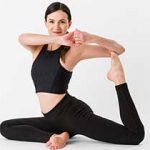To mark BackCare Awareness Week (2nd – 6th October), British Chiropractic Association research revealed the surprising myths chiropractors have heard from their patients about what causes their back pain and the best way to treat it.
Common misconceptions about back pain include thinking a slipped disc means the disc has actually ‘slipped’ out of the spine and that you should always rest a bad back. Hanging off a doorframe and even applying WD40 are some of the strange back pain cures chiropractors across the country have heard from their patients.
According to the BCA at least 65% people in the East Midlands either suffer of have suffered from back or neck pain, with 15% suffering every day.
Whilst these may seem like funny stories, there is a really serious message here. Back pain is very common and if people don’t know enough about what causes it or how best to treat it they could delay their recovery or do themselves more damage. For example many people think you should stop being active if you’re suffering from back pain whereas for most people continuing moderate exercise could be beneficial.
There are plenty of simple things we can all do to help look after our back health. These are my top tips:
- Get up, stand up. Inactivity is a leading cause of back pain. If you spend most of your day sitting make sure that you take regular breaks, ideally every 20-30 minutes. Stand up to stretch, change position and walk around a little.
- Stretch it out. If you struggle to get away from your seat at work, simple activities such as stretching and shoulder shrugging and even simply fidgeting in your seat can all help to keep the joints and muscles in your back moving.
- Keep moving. Exercise is key to a healthy back, however you don’t need to embark on any extreme fitness regimes. Adding just a few extra minutes of walking a day can have a huge impact on your posture.
- Straighten Up. Try incorporating some simple exercises into your daily routine. The British Chiropractic Association has developed – https://chiropractic-uk.co.uk/straighten-up-uk/ – a series of simple exercises designed to improve posture and help prevent back pain by promoting balance, strength and flexibility in the spine.
- Perfect your posture. Paying close attention to your posture can help you recognise back or neck pain triggers. People who want to improve their posture should try imagining they have a plumb line hanging straight from their ears to ankles – with everything in the middle sitting on the same line.One way to do this is to try standing in a relaxed way and then gently contracting the abdominal muscles
More
Many of you will notice that in the clinic each month we have a challenge pinned up. This month we are making it into a competition and entering is very easy! Here is how to do it:
1. Go to https://chiropractic-uk.co.uk/straighten-up-uk/
2. Download the leaflet OR watch the video.
3. Start doing the exercises to strengthen your back and improve your posture.
4. Take a picture of yourself doing the exercises and email it to: reception@beestonchiropractic.co.uk
That’s it! I told you it was easy! Alex has promised there will be a prize for the best photograph so get creative -encourage your friends/work colleagues/children/grandchildren to do join you doing the exercises!
We’d love to use these pictures to promote the clinic but if you’re not keen on us sharing then please state it in your email!

More
Autumn has arrived, bringing shorter days and less light. This change in the amount of light is a signal to animals, plants and, before the light bulb, people, that seasons are changing. While those most dramatically affected are those in the higher latitudes, many people in the UK are negatively affected by this shift.
Seasonal Affected Disorder (SAD), also known as ‘winter depression’ is a type of a type of depression that comes and goes in a seasonal pattern, with symptoms more severe between September and April. The NHS estimates that SAD affects approximately one in 15 people in the UK during the darker months.
Symptoms of SAD include:
- Lethargy, lack of energy, inability to carry out a normal routine
- Sleep problems, difficulty staying awake during the day, but having disturbed nights sleeps
- Loss of libido, disinterest in physical contact
- Anxiety, inability to cope
- Social problems, irritability, disinterest in seeing people
- Depression, feelings of gloom and despondency for no apparent reason
- Craving for carbohydrates and sweet foods, leading to weight gain
Many people in the UK suffer with SAD, so it’s important to remember that you are not alone.
While light therapy is a popular treatment for SAD, lifestyle factors play a large role too. Getting as much natural sunlight as possible is particularly important, as is managing your stress levels. Exercise is also integral to the treatment of SAD. It has long been known that regular exercise is good for our physical health, but studies also show exercise to be of benefit to our mental wellbeing. Exercise gives you control of your body and is a known mood booster. Your chiropractor can give you a general check to make sure that your bones, joints and muscles are functioning properly and advise on the best exercise solution for you.
More
There’s no better time to start strengthening your spine and improve your posture than now!
October 16th is World Spine Day and what better way to celebrate than with some helpful information on how to keep the spine healthy.
Throughout life the spine is required to withstand considerable weight bearing stress, purely as a result of the pressures of daily living. As we age, the discs lose fluid, become tougher, and less able to respond to weight bearing loads. This puts greater stress on the vertebrae and joints, which in turn form new bone around their edges to create a larger area to withstand weight.
The good news is that attention to a healthy lifestyle from an early age can help reduce the effects of ‘wear and tear’ on the spine. Follow these simple steps to reduce the effects of ageing and for proper care of the spine:
- Don’t smoke; it affects the nutrition of the discs
- Avoid excessive alcohol intake; it causes weakened bone because of an interrupted blood supply, and even fractures
- Take moderate exercise on a regular basis; it is essential to overall health as well as good spinal health
- Make sure your diet is rich in vitamins and minerals (particularly calcium) from fresh, wholesome foods

More
As we focus on the dangers of our children carrying too much in their school bags we challenge you to put your brief case, handbag or whatever you carry around day, after day, after day with unnecessary items on a diet. So stop and take a minute to see if you can ditch some stuff or find a more posture safe way of karting it about … how about a little trolley for you heavier items?
Try to ensure that you don’t carry more than 10% of your body weight on a regular basis
… Go on weigh your baggage!
More
 As the shorter days start to roll in, the early signs of our gardens getting ready for Autumn appear with it come the hustle bustle of a new academic year for our young people whether it be a new year at school, a new school, off to college or university, the start of a new job or returning to our old one after a relaxing break. However, we need to be aware of the potential harm we could cause our spines:
As the shorter days start to roll in, the early signs of our gardens getting ready for Autumn appear with it come the hustle bustle of a new academic year for our young people whether it be a new year at school, a new school, off to college or university, the start of a new job or returning to our old one after a relaxing break. However, we need to be aware of the potential harm we could cause our spines:
new uniform
new shoes
hair cuts,
dental checks
and eye tests are probably all on your list to ensure your youngsters get off to the best start – but more and more parents are realising the importance of having their child’s spine checked by a chiropractor.
Worry about heavy school bags and the increase time spent on their technology from phones to play stations is concerning parents as children slouch over their gadgets – let the chiropractors help you support them in preventing long term problems for their spines- Give us a call today.
More
 Children are back in the classrooms, running around playgrounds and playing sports and children, like adults, can be prone to back pain, and there can be several causes:
Children are back in the classrooms, running around playgrounds and playing sports and children, like adults, can be prone to back pain, and there can be several causes:
- Lack of exercise or excessive exercise
- Weight of school bags
- Bad posture
- Poorly set up desks
- Use of a computer or computer games
- Sports injuries
- Ill-fitting shoes/improper shoes
Lack of exercise and excessive exercise
The general finding from various studies is that children involved in competitive sports and those who are sedentary are more prone to getting low back pain while those that participated in moderate activity were protected. The children involved in competitive sports run the risk of getting repetitive strain injuries. Those children who are sedentary are often those who sit and watch a lot of television or play on a computer. The implication of this will be discussed below.
Weight of school bags
School bags are exceptionally heavy for those attending secondary school due to the number of different subjects covered and therefore the number of textbooks required and the fact the children often have to move between classes. Not all children have access to lockers, which mean that books have to carried with them. Bags carried on one shoulder causes an asymmetry of the body and therefore certain muscles will have to tighten and others lengthen in order to carry the bag. These kind of imbalances can cause long-term problems.
Bad posture
All aspects of life can induce bad posture; lack of exercise, weight of school bags, spending too much time playing computer games or on the computer, incorrect shoes, and growth. Those children who grow faster and become taller than their peers may slouch in order to not tower above their friends and this can ultimately lead to bad posture.
Poorly set up desks
Whether at school or home, ill fitting desks can lead to bad posture. School desks and chairs cannot cater for individual heights of children and, as mentioned earlier, the children often have to move between classes. The desks and chairs are uniform and unable to be altered to the child’s individual needs. Guidance on correct desk set up should be implemented at home; not just for the kids but also for everyone in the family who uses the desk. At school this can’t be done, but by advising the child to sit upright and not to slouch and not to cross the legs will help.
Use of a computer or computer games
Any body position requires certain muscles to shorten and others to lengthen. This occurs every time we move. If we were to stay in one position for too long those muscles will eventually stay that particular length. When children play on computer games it quite often requires time. This leads to the above situation with muscles. Children should be encouraged to not spend longer than 30-40 minutes at any one time playing games, using a computer, or even doing homework before having a break. The child should spend a few minutes walking around and then returning to the game/homework by reviewing their posture and sitting correctly.
Sports injuries
Those children who play a lot of sport and those who play contact sports such as rugby may be injured either by direct contact or by overuse of certain muscles. If a child is injured it is advisable that they are seen by a chiropractor as problems unresolved can lead to compensations, ie walking differently due to sprained ankle leading to low back pain, a rugby tackle causing neck pain and headaches.
Ill-fitting shoes/improper shoes
Children are conscious of fashion, which can affect their shoe wear. Girls particularly may wear shoes with a high heel. This causes the calf muscles to shorten and pushes the body forward. To prevent falling over the girl would have to lean back and causing an increase in the low back curvature which can not only cause low back pain but also pain between the shoulder blades.
Wearing improperly fitting shoes can cause many problems from blisters, pressure sores and ingrowing toenails in the short-term, to feet deformities like hammer toe, and knee and posture problems in the long-term. It can take up to 18 years for feet to fully develop, so teenagers feet need to be looked after just as much as younger children’s.
Shoes should be the correct size and offer the right amount of support. When purchasing new shoes, get the child’s feet correctly sized by the shop assistant and ensure that the shoes are the correct length as well as width.
Here’s some advice to help your child:
- Rucksacks should be worn across both shoulders and the straps adjusted so the bag is held close to the body.
- If a locker is available, encourage your child to use it and ensure they only take the books and equipment needed for that day.
- Check their shoes are correctly fitted, supported, relatively flat, and are not too worn.
- Encourage your child to enjoy regular exercise, such as swimming and cycling.
- Use of the computer, playing computer games and homework should be in blocks of no more than 30-40 minutes. Advise them to have a little walk before returning and again that they sit with their shoulders down and back (not slumped) and their legs are uncrossed.
- Please contact us if your child is experiencing pain or discomfort, or even just to get a check up.
More
Summer holidays allow the chance of a lie in but getting your kids motivated, up and ready for school is a whole new challenge that you really don’t want in the mornings.
How about sit down with your children over the weekend and discuss what they are going to make themselves for breakfast, Offer suggestions of a healthy start with lots of protein. Complex carbohydrates and fruit smoothies. Try and avoid sugary cereal and spreads for their toast – this will make them irritable and tired mid-morning. Make sure they have a healthy snack for break time to keep them going till lunch and access to plenty of water.
Try these tips to get them and yourselves up:
Wake up gradually
Many people become irritated by sudden and annoying alarm sounds. Start your day in a better mood by downloading an app that wakes you more gradually, with music or with a tone that gradually increases in volume, easing you in to your morning routine.
At this time of year, light alarm clocks are especially beneficial. These wake you with a gradually brightening light that simulates sunrise. Waking up naturally and gradually this way is much more welcome than being shocked out of a sound sleep.
Nourish your body
Feeling groggy, or even as if you have a hangover, isn’t uncommon when your alarm sounds. However, this may not be caused by tiredness. Bearing in mind that you have not consumed any food or drink for at least 7 hours (hopefully!), you may be dehydrated.
Keep a bottle of water by your bed to drink first thing. If you’re a coffee drinker, try to have a glass or two of water before your brew.
It’s also important to replenish your body with nutrients after a night’s sleep. Avoid opting for high-sugar and high-carbohydrate foods that will cause your blood sugar to spike and then drop just a couple of hours later. Instead, build your breakfast around complex carbohydrates such as oatmeal, proteins such as eggs, and healthy fats like avocado and nuts. Having a nutritious, filling and enjoyable breakfast to look forward can also be a great motivator to get out of bed!
Exercise
Whether you’re a yogi, gym-goer or enjoy a revitalizing morning stroll, exercising in the morning will get your heart pumping oxygen-rich blood around your body, helping you to function more effectively. Exercise can also be a great way to clear your mind, preparing your for a productive and more stress-free morning, and obviously has huge benefit to your health.
Introduce these tips to your morning routine, aiming to commit for at least 21 days. This will help you to form healthy habits that both your mind and body will thank you for!
More
Kids can be at risk from suffering back or neck pain due to sedentary lifestyles and the excessive use of technology.
Findings from the British Chiropractic Association (BCA) show that 40% of 11 to 16 year olds in the UK have experienced back or neck pain. More than one in seven (15%) parents said their son’s or daughter’s pain is a result of using a laptop, tablet or computer.
The research revealed that almost three quarters (68%) of 11 to 16 year olds spend between one and four hours a day on a laptop, tablet or computer and 73% spend between one and six hours on the devices. More than a third (38%) of parents said their child spends between one and six hours a day on their mobile phone.
Chiropractors are now noticing a rise in the number of young people presenting with neck and back problems due to their lifestyle choices. We would encouraging parents to limit the time their children spend using technology and instead encourage more active pastimes.
Based on a two hour period, young people spend more time on games consoles (33%) than doing an activity like riding a bicycle (12%). When asked how much time their teenager spends on their bicycle, one in five (21%) parents admitted that they don’t have one.
Nearly half (46%) of parents questioned, acknowledged that their children don’t spend enough time exercising, despite NHS guidelines stating that children and young people between 5 and 18 years old need to do at least one hour of physical activity every day.
More people under the age of sixteen are being seen with back and neck pain, and technology is so often the cause. Young people are becoming increasingly sedentary which is damaging their posture. There is the tendency to sit in a hunched position when working on computers and laptops, putting a lot of strain on the neck.
Learning how to sit properly and keeping active will help to keep young people healthy and pain free. It’s important that parents seek help for their children from an expert as soon as any pain starts – if conditions are left untreated it could lead to chronic back and neck problems in later life.
The BCA offers the following top tips for parents to help their teenagers reduce the risks of back and neck pain:
- Get your kids moving: The fitter children are, the more their backs can withstand periods of sitting still. To increase fitness levels, your child should be more active which can be achieved by doing activities including walking to school, riding a bike or going for a run.
- Teach them how to sit: It’s important that children learn the correct way to sit when they’re using a computer. Teach them to keep their arms relaxed and close to their body and place arms on the desk when typing. Make sure the top of the screen is level with the eyebrows and the chair is titled slightly forward, allowing for the knees to be lower than the hips and the feet to be flat on the floor. Using a laptop or tablet away from a desk will encourage poor posture, so limit time spent in this way.
- Don’t sit still for too long: Make sure children take a break from the position they’re sitting in on a regular basis and stretch their arms, shrug their shoulders and move their fingers around – this helps to keep the muscles more relaxed.
- Lead by example: Maintaining good posture and promoting good back health is something that everyone should be doing, adults and children alike. If you make it a priority, it’s easier for your children to see the relevance.
- Seek medical advice: Seek professional advice if your child is experiencing pain which has lasted for more than a few days. If your child wants to be more active, check that there are no medical reasons why they should not exercise, particularly if they are not normally physically active.
More
August Challenge
Are you ready to add something new into your training routine – or even just to start a training routine?! This month we challenge you to look as these two different types of exercise that you can use to supplement your Chiropractic care, or just start something new that you have been meaning to!
If you have found a routine that works for looking after your spine and your health then that is fantastic, but here are Andrew’s two favourite online resources for guiding you through two different types of training.
http://yogawithadriene.com/
www.youtube.com/user/yogawithadreine
www.youtube.com/user/JDCAV24

More



 As the shorter days start to roll in, the early signs of our gardens getting ready for Autumn appear with it come the hustle bustle of a new academic year for our young people whether it be a new year at school, a new school, off to college or university, the start of a new job or returning to our old one after a relaxing break. However, we need to be aware of the potential harm we could cause our spines:
As the shorter days start to roll in, the early signs of our gardens getting ready for Autumn appear with it come the hustle bustle of a new academic year for our young people whether it be a new year at school, a new school, off to college or university, the start of a new job or returning to our old one after a relaxing break. However, we need to be aware of the potential harm we could cause our spines: Children are back in the classrooms, running around playgrounds and playing sports and children, like adults, can be prone to back pain, and there can be several causes:
Children are back in the classrooms, running around playgrounds and playing sports and children, like adults, can be prone to back pain, and there can be several causes: